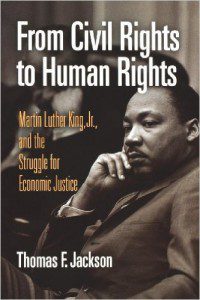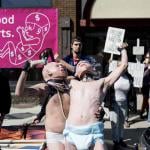In addition to spending time with family and friends on Labor Day Weekend, I try to be mindful that Labor Day is about much more than a three-day weekend, symbolically marking the end of summer. The first Monday in September was set apart as a time to celebrate the labor movement’s role in securing worker’s rights. In the late nineteenth century, an increasing number of states officially recognized Labor Day as a holiday, culminating in Congress declaring Labor Day a federal holiday in 1894.
And the struggles that Labor Day commemorates are not over. Although we might wish that it were otherwise, it is important to be honest that our current economy is not designed to allow everyone to be well paid to do their dream job. Instead, to borrow a term from Karl Marx, the vast majority of humans earn a living through “alienated labor”: work that is not personally fulfilling but must be done to afford even a basic minimum of food and shelter. (There is a whole other discussion for those of us who love our work, do not feel alienated from our labor, yet need to draw boundaries for our longterm health and to make time for our families. But I’d like to set aside those concerns for now.)
It can be easy to forget how much we owe organized labor. As one popular bumper sticker says, “From the People that Brought You the Weekend.” Historically, many people used to spend 12 (or more) hours/day working for six (or seven) days/week. But “in the early nineteenth century and continuing for over a hundred years, working hours in America were gradually reduced — cut in half according to most accounts” (vii). The labor movement pushed back against the exploitation of workers through union organizing and other related collective action.
But here is another oft-forgotten twist. As historian Benjamin Honnicutt has detailed in his fascinating book Free Time: The Forgotten American Dream (Temple University Press, 2013), in the late nineteenth century, extrapolating from the successes of the labor movement, many of the best economists “regularly predicted that, well before the twentieth century ended, a Golden Age of Leisure would arrive, when no one would have to work more than two hours a day” (vii). For those forced to earn a living through alienated labor, working only two hours a day (for a total of ten-hours/week) would mean having time to pursue the American Dream of “Life, Liberty, and the pursuit of Happiness” instead of returning home from work too exhausted to do anything but rest briefly before dragging yourself out to go back to work the next day.
Labor activists did help secure a five-day work week — and in some industries even a six-hour work day. But starting with the Great Depression in the 1930s, the trend of shortening work hours reversed. A new emphasis arose on the perceived need to grow the economy through perpetually increasing consumer demand. So we find ourselves working more and more to buy more and more stuff — but not having any free time to enjoy that stuff, much less our family and friends.
Today we know that the labor rights movement has continued to lose ground on many fronts. Here in the early twenty-first century, many of us work not a ten-hour week, but a 10- or 12-hour day, building to a 50-hour, 60-hour (or more) work week (viii). And ironically, as our collective productivity at work has grown 72.2 percent over the past four decades, hourly compensation has grown only 9.2 percent (Rieger 34-35).
With the decline of the labor rights movement, many corporations now perceive themselves as responsible not to their workers, but solely to their stockholders (38). And at the same time that labor rights for us human beings have been rolling back, Supreme Court decisions like Citizens United have been busy defending the rights of corporate personhood, making the playing field even more unequal. If anyone is curious, I will readily grant that organized labor has also had a sizable share of corruption in its history.
But overall, the balance of political power in the U.S. has shifted away from worker’s rights and toward corporate rights.
To name one vision for what we could choose to move toward as a society, I invite you to consider Article 23 of the U.N. Declaration of Human Rights:
(1) Everyone has the right to work, to free choice of employment, to just and favorable conditions of work and to protection against unemployment.
(2) Everyone, without any discrimination, has the right to equal pay for equal work.
(3) Everyone who works has the right to just and favorable remuneration ensuring for himself and his family an existence worthy of human dignity, and supplemented, if necessary, by other means of social protection.
(4) Everyone has the right to form and to join trade unions for the protection of his interests.
The Rev. Dr. Martin Luther King, Jr.’s name for a world founded on a respect for human rights was the “beloved community.” And in addition to all the ways that Dr. King talked about his dream of beloved community, he also reminded his audiences that the greatest hindrance to building the Beloved Community is not racism alone, but the interlocking “triple threats” of racism, materialism, and militarism (91).
 So on this day after Labor Day, I’d like to reflect on Dr. King’s journey in conversation with the book From Civil Rights to Human Rights: Martin Luther King, Jr., and the Struggle for Economic Justice (University of Pennsylvania Press, 2009) by Thomas F. Jackson for the ways in which MLK’s increasing focus on both racial and economic justice can inform and inspire us today.
So on this day after Labor Day, I’d like to reflect on Dr. King’s journey in conversation with the book From Civil Rights to Human Rights: Martin Luther King, Jr., and the Struggle for Economic Justice (University of Pennsylvania Press, 2009) by Thomas F. Jackson for the ways in which MLK’s increasing focus on both racial and economic justice can inform and inspire us today.
In tracing the arc of Dr. King’s life, it is significant to remember that despite the indelible mark he left behind on our society and around the world, his public ministry lasted for barely more than a decade from 1956 until his assassination in 1968 at the far too young an age of 39. (It is stunning to me that when King was killed, he was only one year older than I am now.)
Dr. King’s strong commitment to economic justice was clear at the end of his life. When he was killed in Memphis, he was in town helping lead a sanitation workers’ strike. And later that month he was scheduled to lead a Poor People’s Campaign to protest in Washington, D.C. But the twin themes of both racial and economic justice were also there from the beginning. Consider, for example, that the full name of that famous 1963 protest in D.C. was the “March on Washington for Jobs and Freedom.” If you go back and look at archival photos and footage from that march, you’ll see not only signs for “End segregated rules in public schools” and “We demand voting rights now!” but also signs demanding “Full employment” and “We march for jobs for all now” (173).
And in King’s famous “I Have a Dream” speech, he didn’t just talk about a future of children playing together across color lines, he said:
In a sense we’ve come to our nation’s capital to cash a check. When the architects of our republic wrote the magnificent words of the Constitution and the Declaration of Independence, they were signing a promissory note…that all men…would be guaranteed the “unalienable Rights” of “Life, Liberty and the pursuit of Happiness.” It is obvious today that America has defaulted on this promissory note…. Instead of honoring this sacred obligation, America has given the Negro people a bad check, a check which has come back marked “insufficient funds.” But we refuse to believe that the bank of justice is bankrupt. We refuse to believe that there are insufficient funds in the great vaults of opportunity of this nation. And so, we’ve come to cash this check, a check that will give us upon demand the riches of freedom and the security of justice.
Or as King would say later: “What does it profit a man to be able to eat at an integrated lunch counter if he doesn’t earn enough money to buy a hamburger and a cup of coffee” (Rieger 4)?
And here’s a vital point. If you continue to trace the logic of how King’s speeches evolved, he increasingly followed a model similar to the one Thomas Jefferson used centuries earlier. Jefferson did not declare our independence from the King of England based on the reasoning of British Common Law. He claimed our freedom based on “self-evident” truths and “certain unalienable Rights.” Likewise, more than merely seeking to get laws passed by civil government (which is important), King came to see the struggle against poverty and racism as part of a worldwide human rights movement that supersedes mere laws. As the saying goes, “An unjust law is no law at all.”
Part of what is most significant to me about King’s life is that his path to becoming a Civil Rights leader and human rights activist was neither inevitable nor even predictable. And one theme I want us to explore this fall from a few different angles in forthcoming posts is how people with power and privilege come to be in authentic solidarity with oppressed groups. Specifically in the life of MLK, although The Rev. Martin Luther King, Sr. was born into an exploitative sharecropping system, by the time King, Jr. was born in 1929, his father was a minister in Atlanta who was doing well financially (25). King, Jr. could have chosen to follow in his father’s footsteps, spending his life preaching from a well-paying pulpit.
As had his father before him, King, Jr. attended the historically black Morehouse College, graduating at age 19 with a degree in sociology (32). He went on to earn a masters of divinity from the predominantly white seminary in 1951 before earning a Ph.D. from Boston University (33). One of the ways that King began to discern a call to movement for justice far larger than himself is through his education. In 1951, the same year he graduated seminary, “He told his then-girlfriend, Coretta Scott, that he was not pro-capitalist like his father and had no ambitions to wealth.” In his ringing turn of phrase, capitalism took “necessities from the masses to give luxuries to the classes” (42).
At the same time, I should be clear that King also criticized extreme socialism or collectivism as neglecting the ways that “life is individual and personal” (42-43). In many ways, King’s maturing views can be seen as moving toward what is sometimes called the “Triple Bottom Line” of People, Planet, and Profit. Profit motive is still a major factor, but instead of seeing profit for stockholders as the only “bottom line,” financial gain is balanced with people (labor rights) and planet (environmental sustainability). That Triple Bottom Line of People, Planet, and Profit is one vision of what a twenty-first century labor movement might look like.
By understanding how much has changed in the past through the labor movement (moving from a 12-hour day and a 6-7 day work week to an 8-hour day and a 40-hour work week), we can begin to imagine the ways that our current relationship with work can also change for the future — so that increasingly numbers of us might have less alienated labor and more free time for “life, liberty, and the pursuit of happiness. Perhaps too like Dr. King many years ago, you may be feeling the inkling of a call within you to act for a cause great than yourself — to join (or increase your commitment to) the work of building beloved community. May we support one another in the struggle for Collective Liberation!
The Rev. Dr. Carl Gregg is a trained spiritual director, a D.Min. graduate of San Francisco Theological Seminary, and the minister of the Unitarian Universalist Congregation of Frederick, Maryland. Follow him on Facebook (facebook.com/carlgregg) and Twitter (@carlgregg).
Learn more about Unitarian Universalism: http://www.uua.org/beliefs/principles
















